-
History & Society
- Education in Pre-war Hong Kong
- History of Taikoo Sugar Refinery
- Hong Kong Products Exhibition
- Local Festivals Around the Year
- Post-war Industries
- Pre-war Industry
- The Hong Kong Jockey Club Archives
- Tin Hau Festival
- Memories We Share: Hong Kong in the 1960s and 1970s
- History in Miniature: The 150th Anniversary of Stamp Issuance in Hong Kong
- A Partnership with the People: KAAA and Post-war Agricultural Hong Kong
- The Oral Legacies (I) - Intangible Cultural Heritage of Hong Kong
- Hong Kong Currency
- Hong Kong, Benevolent City: Tung Wah and the Growth of Chinese Communities
- The Oral Legacies Series II: the Representative List of the Intangible Cultural Heritage of Hong Kong
- Braving the Storm: Hong Kong under Japanese Occupation
- A Century of Fashion: Hong Kong Cheongsam Story
Geography & EnvironmentArt & Culture- Calendar Posters of Kwan Wai-nung
- Festival of Hong Kong
- Ho Sau: Poetic Photography of Daily Life
- Hong Kong Cemetery
- Sketches by Kong Kai-ming
- The Culture of Bamboo Scaffolding
- The Legend of Silk and Wood: A Hong Kong Qin Story
- Journeys of Leung Ping Kwan
- From Soya Bean Milk To Pu'er Tea
- Applauding Hong Kong Pop Legend: Roman Tam
- 他 FASHION 傳奇 EDDIE LAU 她 IMAGE 百變 劉培基
- A Eulogy of Hong Kong Landscape in Painting: The Art of Huang Bore
- Imprint of the Heart: Artistic Journey of Huang Xinbo
- Porcelain and Painting
- A Voice for the Ages, a Master of his Art – A Tribute to Lam Kar Sing
- Memories of Renowned Lyricist: Richard Lam Chun Keung's Manuscripts
- Seal Carving in Lingnan
- Literary Giant - Jin Yong and Louis Cha
-
History & SocietyGeography & EnvironmentArt & Culture
-
View Oral History RecordsFeatured StoriesAbout Hong Kong Voices
-
Hong Kong Memory
- Collection
- All Items
- European-managed Industries
Recently VisitedEuropean-managed Industries
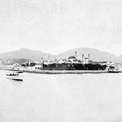
- China Sugar Refining Company
China Sugar Refinery Co. Ltd. was established by Messrs. Jardine, Matheson & Co., Ltd. in 1878. The factory was built at East Point, Causeway Bay, where the factory had close proximity to the harbour for loading cargoes of raw sugar cane and packed products. The sugar cane was imported from Java, the Philippines, the Straits Settlements and various Chinese ports. The factory covered an area of several acres, and equipped with machineries for every process of refining the sugars. The final refined product was fine, white crystal sugar. A lower class of brown sugar was extracted from the syrup. After all the crystallized sugar was extracted, the syrup or molasseses can be marketed in its final form or used in the manufacture of spirits. Sugars can be made into loaf, cube, powder or icing for uses. A laboratory is provided in which European chemists made analyses and tests of the sugar at various stages of its refinement.
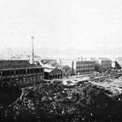
- Hongkong Cotton-Spinning, Weaving, and Dyeing Company, Ltd.
The Hongkong Cotton-Spinning, Weaving, and Dyeing Company, Ltd. was formed in 1898 by Messrs. Jardine, Matheson & Co., Ltd. The factory was built in Causeway Bay and covered a very large area. There were 55,500 spindles in the large factory. The raw cotton came from India primarily and the yarn produced were marketed to China. The company closed its operation in Hong Kong in 1914, and the production was moved to Shanghai.
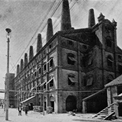
- Facilities of Green Island Cement Company, Ltd.
The Green Island Cement Company was established in 1890 by the Messrs. Shewan, Tomes & Co. It was initially built on the Green Island near Macao and in 1899 a larger and more fully equipped factory was opened in Hong Kong, in Hok Yuen, an area on the Kowloon side of the harbour. Raw materials for the manufacture of cement in Hong Kong consisted of hard limestone, clay, iron ore, gypsum and coal. The two essential components - clay and iron ore - were available from the soil of Hong Kong, whereas limestone was brought from the neighbourhood of Canton. Green Island cement was comparable to the best English and European manufacture, the more famous products in the 1950s were Portland cement as well as Low Heat and Sulphate Resisting Cement. The company was also agents in Hong Kong for the largest cement manufacturers in the world. It also imported and distributed a number of other imported products to the local construction sites.
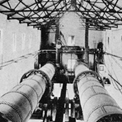
- Green Island Cement Company, Ltd.
The Green Island Cement Company was established in 1890 by the Messrs. Shewan, Tomes & Co. It was initially built on the Green Island near Macao and in 1899 a larger and more fully equipped factory was opened in Hong Kong, in Hok Yuen, an area on the Kowloon side of the harbour. Raw materials for the manufacture of cement in Hong Kong consisted of hard limestone, clay, iron ore, gypsum and coal. The two essential components - clay and iron ore - were available from the soil of Hong Kong, whereas limestone was brought from the neighbourhood of Canton. Green Island cement was comparable to the best English and European manufacture, the more famous products in the 1950s were Portland cement as well as Low Heat and Sulphate Resisting Cement. The company was also agents in Hong Kong for the largest cement manufacturers in the world. It also imported and distributed a number of other imported products to the local construction sites.
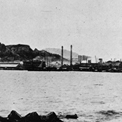
- Factory site of Green Island Cement Company, Ltd.
The Green Island Cement Company was established in 1890 by the Messrs. Shewan, Tomes & Co. It was initially built on the Green Island near Macao and in 1899 a larger and more fully equipped factory was opened in Hong Kong, in Hok Yuen, an area on the Kowloon side of the harbour. Raw materials for the manufacture of cement in Hong Kong consisted of hard limestone, clay, iron ore, gypsum and coal. The two essential components - clay and iron ore - were available from the soil of Hong Kong, whereas limestone was brought from the neighbourhood of Canton. Green Island cement was comparable to the best English and European manufacture, the more famous products in the 1950s were Portland cement as well as Low Heat and Sulphate Resisting Cement. The company was also agents in Hong Kong for the largest cement manufacturers in the world. It also imported and distributed a number of other imported products to the local construction sites.
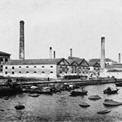
- Hongkong Ice Company Ltd.
The Hongkong Ice Company, Ltd. Before 1874, ice was imported by the Tudor Ice Company from America. The sailing ships with the imported ice anchored close to the foot of Ice House Lane and the ice blocks were stored in the government's Ice Depot. The Ice House Street was named accordingly. In 1874, two Scotchmen erected two damp-air machines and used them to produce ice in Hong Kong. The machines were sold to Messrs. Jardine, Matheson & Co., who formed the business into the Hong Kong Ice Company in 1879. The factory was built in East Point, Causeway Bay, and the two damp-air machines were replaced by three amonia compression machines. The ice produced was carted to the town depot but to shipping it was sent directly by boat, due to its convenience to the harbour. In 1900, the company built a range of insulated cold stores and used them for storing meat, butter, etc. from Australia and supplied them to the British naval and military forces. In 1884, the company bought the ice house from the government and turned it into office and ice depot.
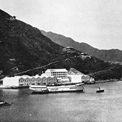
- Hongkong Milling Company
The Junk Bay Flour Mills of the Hongkong Milling Company. The company was established by Messrs. A.H. Rennie & Co. in 1907. In 1905, the company acquired 435 acres of land on the shores of Junk Bay with a sea frontage of 2.5 miles, and in 1907 it began production 24 hours a day. The factory produced 8,000 bags of high quality flour daily and became one of the largest industries in Hong Kong as well as in East Asia.

- Hongkong Industries
This essay reviews the history and operation of the major industries run by European companies in Hong Kong in the 19th Century to early 1900s.

- Industries of Hongkong
This short essay published by the Bedikton Company reviews the general situation of different industries in Hong Kong from 1841 to 1935.

- Industries (1908)
This report was originally under the section of "Trade and Shipping, Industries, Fisheries, Agriculture and Land" of the Administrative Reports for the year 1908. It reported on the conditions, operation of major companies, and import and export trends of selected industries in the year. From 1908 to 1926, this heading continuously appeared in the government administrative reports.
Copyright © 2012 Hong Kong Memory. All rights reserved.
| Set Name |





